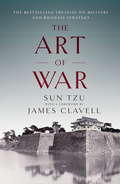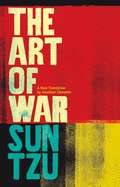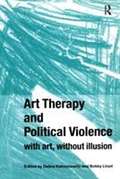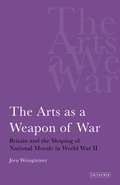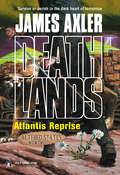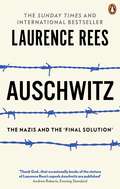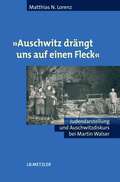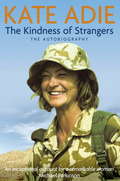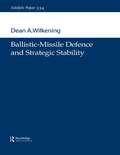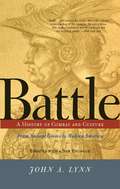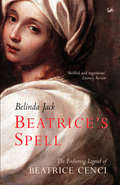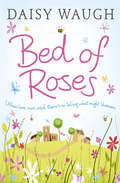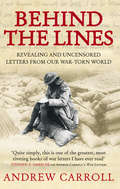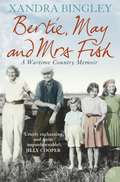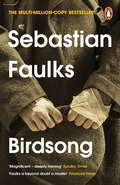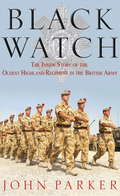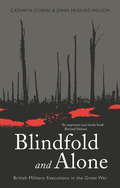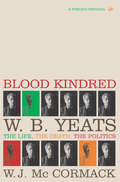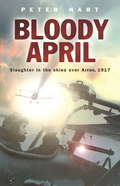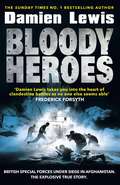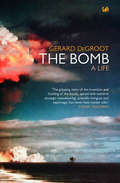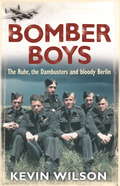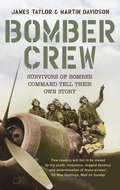- Table View
- List View
The Art of War: The Essential Translation Of The Classic Book Of Life (Penguin Modern Classics Ser. #909)
by James Clavell Sun TzuSun Tzu was one of the greatest army generals who ever lived. He wrote The Art of War in the fifth century BC and yet his words are still resoundingly relevant to our modern lives. His writings on aspects of warfare from the laying of plans to the tactics and psychology of manoeuvering an army, to the proper use of spies, resonate for us in today's world of cut-throat, ruthless business. With James Clavell's insightful foreword and notes, this classic is widely seen as a necessity on the bookshelf of military leaders and boardroom executives alike.
The Art of War: A New Translation (Penguin Modern Classics Ser. #909)
by Jonathan ClementsA new translation for the 21st century.The Art of War by Sun Tzu is one of the most influential political and business books of our era. This gateway edition for the 21st century reader rediscovers the essential clarity of the ancient masterpiece, cited by generals from a dozen Chinese dynasties, international business leaders, and modern military field manuals.This edition also contains a full commentary on Sun Tzu, the man and his ideas, contemporary of Confucius and Buddha; and a critical guide to further reading. This is the perfect introduction to one of the world's best-known classics.
Art Therapy And Political Violence: With Art, Without Illusion (PDF)
by Bobby Lloyd Debra Kalmanowitz Shaun McNiff Diane WallerThe impact of political violence, war, civil war and acts of terrorism on the individuals involved can be extensive. Art therapy can provide an effective means of expressing the resulting experiences of fear, loss, separation, instability and disruption. Art Therapy and Political Violence brings together contributions from all over the world and from diverse theoretical backgrounds. With contributions from Northern Ireland, Kosovo, Israel and South Africa, the book includes numerous clinical examples to vividly illustrate the main issues affecting art therapy. The practical issues involved are also discussed, including subjects such as the importance of working with both the internal and external worlds of the individual and sensitivity to cultural issues. Art therapists, psychotherapists and other mental health professionals, particularly those working in the context of political violence or in countries of refuge, will find the experiences recounted in Art Therapy and Political Violence thought-provoking and will welcome the wealth of practical information provided.
Art Therapy And Political Violence: With Art, Without Illusion
by Bobby Lloyd Debra Kalmanowitz Shaun McNiff Diane WallerThe impact of political violence, war, civil war and acts of terrorism on the individuals involved can be extensive. Art therapy can provide an effective means of expressing the resulting experiences of fear, loss, separation, instability and disruption. Art Therapy and Political Violence brings together contributions from all over the world and from diverse theoretical backgrounds. With contributions from Northern Ireland, Kosovo, Israel and South Africa, the book includes numerous clinical examples to vividly illustrate the main issues affecting art therapy. The practical issues involved are also discussed, including subjects such as the importance of working with both the internal and external worlds of the individual and sensitivity to cultural issues. Art therapists, psychotherapists and other mental health professionals, particularly those working in the context of political violence or in countries of refuge, will find the experiences recounted in Art Therapy and Political Violence thought-provoking and will welcome the wealth of practical information provided.
The Arts as a Weapon of War: Britain and the Shaping of National Morale in World War II
by Jorn WeingartnerIn 1834, Lord Melbourne spoke the words that epitomised the British government's attitude towards its own involvement in the arts: 'God help the minister that meddles with Art'. However, with the outbreak of World War II, that attitude changed dramatically when 'cultural policy' became a key element of the domestic front. Not only a propaganda tool, it aimed to boost morale and prevent a wartime cultural blackout. "The Arts as a Weapon of War" traces the evolution of this policy from the creation of the Committee for the Encouragement of Music and the Arts, in 1939, to the drafting of the Arts Council's constitution in 1945. From the improvement of the National Gallery to Myra Hess' legendary concerts during the blitz, Jorn Weingartner provides a fascinating account of the powerful policy shift that laid the foundations for the modern relationship between government and the arts.
Atlantis Reprise
by James AxlerFor Ryan Cawdor, leader of a small group of post-apocalypse survivalists, it's the inner fire of survival that guides them through this hell on earth…to whatever lies beyond the daily fight for existence. There are times when the oblivion of death seems a most welcome journey out of Deathlands.
Auschwitz: A New History (Histoire Ser. #Vol. 6015861)
by Laurence ReesIn this compelling book, highly acclaimed author and broadcaster Laurence Rees tells the definitive history of the most notorious Nazi institution of them all. We discover how Auschwitz evolved from a concentration camp for Polish political prisoners into the site of the largest mass murder in history - part death camp, part concentration camp, where around a million Jews were killed. Auschwitz examines the mentality and motivations of the key Nazi decision makers, and perpetrators of appalling crimes speak here for the first time about their actions. Fascinating and disturbing facts have been uncovered - from the operation of a brothel to the corruption that was rife throughout the camp. The book draws on intriguing new documentary material from recently opened Russian archives, which will challenge many previously accepted arguments.This is the story of murder, brutality, courage, escape and survival, and a powerful account of how human tragedy of such immense scale could have happened.
"Auschwitz drängt uns auf einen Fleck": Judendarstellung und Auschwitzdiskurs bei Martin Walser
by Matthias N. LorenzIst Martin Walser ein "geistiger Brandstifter", sein Roman 'Tod eines Kritikers' ein antisemitischer Text? Was ist überhaupt "literarischer Antisemitismus"? Der Verfasser zeichnet die für das deutsche Selbstverständnis so signifikante Walser-Debatte nach, um davon ausgehend den Blick zurück auf das Gesamtwerk des Autors zu richten. Er setzt akribische Lektüren gegen eine Philologie des Verdachts, aber auch gegen blinde Apologie. Sein Befund: Walsers in den 1990er Jahren offenkundig gewordenen Ressentiments sind selbst in jenen Werken angelegt, die längst zum Kanon der so genannten "Vergangenheitsbewältigung" zählen. Im Anhang ein Interview mit Martin Walser vom 15. Juli 2003. "Die Untersuchung von Matthias N. Lorenz macht der Spekulation und Mutmaßung ein Ende." Wolfgang Benz.
The Autobiography: The Autobiography
by Kate AdieKate Adie's story is an unusual one. Raised in post-war Sunderland, where life was 'a sunny experience, full of meat-paste sandwiches and Sunday school', she has reported memorably and courageously from many of the world's trouble spots since she joined the BBC in 1969. THE KINDNESS OF STRANGERS encompasses Adie's reporting from, inter alia, Northern Ireland, the Middle East, Tiananmen Square and, of course, the Gulf War of 1991. It offers a compelling combination of vivid frontline reporting and evocative writing and reveals the extraordinarily demanding life of the woman who is always at the heart of the action. Although an intensely private person, Kate Adie also divulges what it's like to be a woman in a man's world - an inspiration to many working women.
Ballistic-Missile Defence and Strategic Stability (Adelphi series)
by Dean A. WilkeningShould the US deploy ballistic-missile defences? The arguments for and against are becoming increasingly polarised. This paper offers what is currently lacking in the debate: a quantitative analysis of how well defences would have to work to meet specific security objectives, and what level of defence might upset strategic stability.
Ballistic-Missile Defence and Strategic Stability (Adelphi series #334)
by Dean A. WilkeningShould the US deploy ballistic-missile defences? The arguments for and against are becoming increasingly polarised. This paper offers what is currently lacking in the debate: a quantitative analysis of how well defences would have to work to meet specific security objectives, and what level of defence might upset strategic stability.
Battle: A History Of Combat And Culture
by John A LynnBattle: A History of Combat and Culture spans the globe and the centuries to explore the way ideas shape the conduct of warfare. Drawing its examples from Europe, the Middle East, South Asia, East Asia, and America, John A. Lynn challenges the belief that technology has been the dominant influence on combat from ancient times to the present day. In battle, ideas can be more far more important than bullets or bombs. Carl von Clausewitz proclaimed that war is politics, but even more basically, war is culture. The hard reality of armed conflict is formed by - and, in turn, forms - a culture's values, assumptions, and expectations about fighting. The author examines the relationship between the real and the ideal, arguing that feedback between the two follows certain discernable paths. Battle rejects the currently fashionable notion of a "Western way of warfare" and replaces it with more nuanced concepts of varied and evolving cultural patterns of combat. After considering history, Lynn finally asks how the knowledge gained might illuminate our understanding of the war on terrorism.
Beatrice's Spell: The Enduring Legend of Beatrice Cenci
by Belinda JackBeatrice Cenci was executed in Rome in September 1599: she was said to be sixteen, and was hauntingly beautiful. Her crime was the murder of her father, a member of one of the greatest Roman families, but his cruel treatment of her, including incestuous rape, moved the people of the city to take her side. Weeping crowds lined the streets, and a special mass is still said in Rome on the anniversary of her death. She was at once innocent and guilty, the victim and the perpetrator of appalling crimes. From that time since, the ambivalent image of Beatrice has attracted writers and artists, and often their obsession with her fed their own self-destruction. In this compelling study, Belinda Jack takes on the dangerous challenge of bringing Beatrice to life, and of tracing her power over those who tried to resurrect her, from the tragedy of Shelley to the novels of Nathaniel Hawthorne and Herman Melville, from the sculpture of Harriet Hosmer and the photographs of Julia Margaret Cameron to the desperate drama of Antonin Artaud. As we follow the stories of their lives and ambitions, we see how they suffered critical condemnation for their works about Beatrice, and were sometimes pushed to the brink of insanity. Her story, which is one of lust, passion and violence, contains a powerful sense of the forbidden, the taboo that drives people over the edge. Beatrice's Spell is at once scholarly and utterly engrossing, carrying the power of her story through time.
Bed of Roses
by Daisy WaughA fun, feelgood romp of country life from bestselling author Daisy Waugh
Behind The Lines: Revealing and uncensored letters from our war-torn world
by Andrew Carroll'Quite simply, this is one of the greatest, most riveting books of war letters I have ever read.' Stephen E. Ambrose on War LettersIn 2001 Andrew Carroll authored the US top ten bestseller, War Letters - a unique compilation of extraordinary correspondence from American soldiers serving in US conflicts throughout history. Following the publication of this landmark work Andrew was inundated with letters from soldiers all around the world (to date he has a staggering 75,000 letters). Inspired by these messages he embarked on a quest to discover other previously unpublished letters written during conflicts around the globe. For three years Andrew travelled the world zealously collecting letters from over 35 different countries including Great Britain. Behind the Lines is the remarkable anthology that has been put together as a result of this work.The first book of its kind, Behind the Lines will be a dramatic, intimate and unprecedented look at warfare as seen through the eyes of troops and civilians. Unparalleled in geographical and historical scope it covers all major global conflicts from World War I and II and the American Revolution, up to Afghanistan and Iraq. Featuring never-before-seen letters and emails from war zones, and including the memories and thoughts from those on both sides of the hostilities documented, Behind the Lines will be a truly emotive and poignant depiction of war assembled by a uniquely talented and driven author who always keeps the general reader and narrative in mind.
Bertie, May and Mrs Fish: Country Memories Of Wartime
by Xandra BingleyA lyrical, evocative and wonderfully original wartime memoir about life on a farm in the Cotswolds, seen through the eyes of a child.
Birdsong (Oberon Modern Plays Ser.)
by Sebastian FaulksBirdsong is a mesmerising story of love and war spanning three generations between WW1 and present dayThe wartime classic behind the BBC drama starring Eddie RedmayneTHE SUNDAY TIMES BESTSELLER1910. Amiens, Northern France. Stephen Wraysford, a young Englishman, arrives in the French city to stay with the Azaire family. He falls in love with unhappily married Isabelle and the two enter a tempestuous love affair. But, with the world on the brink of war, the relationship falters. With his love for Isabelle forever engraved on his heart, Stephen volunteers to fight on the Western Front and enters the unimaginable dark world beneath the trenches of No Man’s Land. From award-winning writer Sebastian Faulks, Birdsong is an exceptionally moving and unforgettable portrait of the ruthlessness of war and the indestructability of love. ‘Magnificent – deeply moving’ Sunday Times----Also available by Sebastian Faulks as part of the French trilogy series: The Girl at the Lion d’Or Charlotte Gray
Black Watch: The Inside Story Of The Oldest Highland Regiment
by John ParkerThe Black Watch is one of the finest fighting forces in the world and has been engaged in virtually every worldwide conflict for the last three centuries. Named after the dark tartan of the soldiers' kilts, it is the oldest Highland regiment. As part of the British army, their first battle abroad was in Flanders in 1745 but the regiment soon moved to North America to fight the French, and then shared the capture of Montreal, the Windward Islands and Martinique. The American War of Independence saw the regiment once again in America, fighting horrific battles and eventually storming Fort Washington in 1776. Since then the regiment has held its own from the Napoleonic Wars to the Indian mutiny to Iraq. The Black Watch is the UK's most decorated regiment, combining the proud history and tradition of an organisation that has been soldiering for over 250 years.
Blindfold and Alone: British Military Executions In The Great War (Cassell Military Paperbacks Ser.)
by John Hughes-Wilson Cathryn M CornsThree hundred and fifty-one men were executed by British Army firing squads between September 1914 and November 1920. By far the greatest number, 266 were shot for desertion in the face of the enemy. The executions continue to haunt the history of the war, with talk today of shell shock and posthumous pardons.Using material released from the Public Records Office and other sources, the authors reveal what really happened and place the story of these executions firmly in the context of the military, social and medical context of the period.
Blood Kindred: W. B. Yeats, the Life, the Death, the Politics
by W J McCormackIn June 1934, W. B. Yeats gratefully received the award of a Goethe-Plakette from Oberburgermeister Krebs, four months after his early play The Countess Cathleen had been produced in Frankfurt by SS Untersturmfuhrer Bethge. Four years later, the poet publicly commended Nazi legislation before leaving Dublin to die in southern France. These hitherto neglected, isolated and scandalous details stand at the heart of this reflective study of Yeats's life, his attitudes towards death, and his politics.Blood Kindred identifies an obsession with family as the link connecting Yeats's late engagement with fascism to his Irish Victorian origins in suburban Dublin and industrializing Ulster. It carefully documents and analyses his involvement with both Maud Gonne and her daughter Iseult, his secretive consultations with Irish army officers during his Senate years, his incidental anti-Semitism, and his approval of the right-wing royalist group L'Action Française in the 1920s. The familiar peaks and troughs of Irish history, such as the 1916 Rising and the death of Parnell, are re-oriented within a radical new interpretation of Yeats's life and thought, his poetry and plays. As far as possible Bill McCormack lets Yeats speak for himself through generous quotation from his newly accessible correspondence. The result is a combative, entertaining biography which allows Ireland's greatest literary figure to be seen in the round for the first time.
Bloody April: Slaughter in the Skies over Arras, 1917
by Peter HartThe story of the decimation of the Royal Flying Corps over Arras in 1917As the Allies embarked upon the Battle of Arras, they desperately needed accurate aerial reconnaissance photographs. But by this point the Royal Flying Club were flying obsolete planes. The new German Albatros scouts massively outclassed them in every respect: speed, armament, ability to withstand punishment and manoeuverability. Many of the RFC's pilots were straight out of flying school - as they took to the air they were sitting targets for the experienced German aces. Over the course of 'Bloody April' the RFC suffered casualties of over a third. The average life expectancy of a new subaltern on the front line dropped to just eleven days. And yet they carried on flying, day after day, in the knowledge that, in the eyes of their commanders at least, their own lives meant nothing compared to the photographs they brought back, which could save tens of thousands of soldiers on the ground. In this book Peter Hart tells the story of the air war over Arras, using the voices of the men who were actually there.
Bloody Heroes: The Explosive True Story Of A Band Of Secret Warriors In Afghanistan
by Damien LewisIn the Afghan wild lands, British and American special forces soldiers ate, slept, fought and died alongside each other - working in close-knit units the likes of which have rarely been seen since the Second World War. This is the story of the trials and exploits, the victories and defeats, of one of those units. This book takes us from the first ever assault against a terrorist ship carrying weapons of mass destruction to attack London, to the epic siege of the terrorist-held Qala-I-Janghi fortress in Afghanistan. In the interim, our half-a-dozen soldier-characters deliver suitcases stuffed with millions of dollars in cash to 'friendly' Afghan warlords; they penetrate the towering heights of the uncharted Naka Valley, where allied intelligence has identified the mother of all terrorist training camps; they fight in the labyrinthine tunnels running beneath the Afghan mountains; and they risk all to rescue their fellow soldiers from a downed aircraft stranded on a snow-blasted mountain peak. The book culminates in the single battle in which more terrorists were killed than any other in Afghanistan: the siege of Qala-I-Janghi, an ancient mud-walled fortress used to imprison the most dangerous Taliban and Al Qaeda fighters. The battle for Qala-I-Janghi would last a staggering eight days, from the moment of the first shots being fired at the start of the uprising to the hour that the fort yielded up the last Al Qaeda fighters. It is a battle in which over 500 terrorists would die - but which would also claim the life of a US serviceman and dozens of Northern Alliance allies, with scores of severely wounded British and American soldiers. And in the final denouement, this savage battlefield turns out to be populated by the most ultimately shocking enemy - John Walker Lindh, the white American Taliban who held out in the forts' bunker until the very last. At the same time as the story of the fort siege played out on TV screens all across the world, our band of British and American special forces were involved in a secret, deadly dual to rescue their fellow men - a duel that only one side could win.
The Bomb: A Life
by Gerard DeGrootBefore the Bomb, there were simply 'bombs', lower case. But it was the twentieth century, one hundred years of almost incredible scientific progress, that saw the birth of the Bomb, the human race's most powerful and most destructive discovery. In this magisterial and enthralling account, Gerard DeGroot gives us the life story of the Bomb, from its birth in the turn-of-the-century physics labs of Europe to a childhood in the New Mexico desert of the 1940s, from adolescence and early adulthood in Nagasaki and Bikini, Australia and Siberia to unsettling maturity in test sites and missile silos all over the globe. By turns horrific, awe-inspiring and blackly comic, The Bomb is never less than compelling.
Bomber Boys: The RAF Offensive of 1943 (Wn Military Ser.)
by Kevin WilsonA gripping account of the everyday heroism of British bomber crews in 1943 - the year when Bomber Command believed it could win WWII by bombing alone.In 1943 the RAF began a bombing campaign against Germany, the like of which had never before been seen. Over the next twelve months, tens of thousands of aircrews flew across the North Sea to drop their bombs on German cities. They were opposed not only by the full force of the Luftwaffe, but by a nightmare of flak, treacherously icy conditions, and constant mechanical malfunction. Most of these crews never finished their tour of operations but were either shot down and killed, or taken prisoner by an increasingly hostile enemy.This is the story of the everyday heroism of British bomber crews in the days when it was widely believed that the Allies could win the Second World War by bombing alone. Kevin Wilson has interviewed hundreds of former airmen about what their lives were like in 1943: the stomach-churning tension of flying repeatedly over hostile territory, the terror at being shot down or captured, and the peculiar mixture of guilt and pride at unleashing such devastation on Germany.
Bomber Crew
by James Taylor & Martin DavidsonLong after the Battle of Britain, the aircrews of RAF Bomber Command risked their lives night after night during the Second World War. Over 55,000 of the airmen never returned from these missions; a further 10,000 became prisoners of war. And yet Bomber Command has been mired in controversy and its veterans - all volunteers - have never been awarded a campaign medal. Their crucial contribution to the outcome of the war has all too often been overlooked. BOMBER CREW exposes the bravery of these men using gripping first-person testimony from the surviving pilots and crew. For them this was a time of incredible hardship and adrenaline, courage and friendship, and their stories bear witness to the strength of the human spirit in times of incredible danger. Never before has their story been so vividly told. This is also a revealing look at the history of Bomber Command itself, from the early days through to eventual victory in 1945. From the terrifying action of the bombing raids to the intimate personal accounts of heroism, tragedy and triumph, this is the ultimate account of these brave men and their contribution to the Allied victory.
